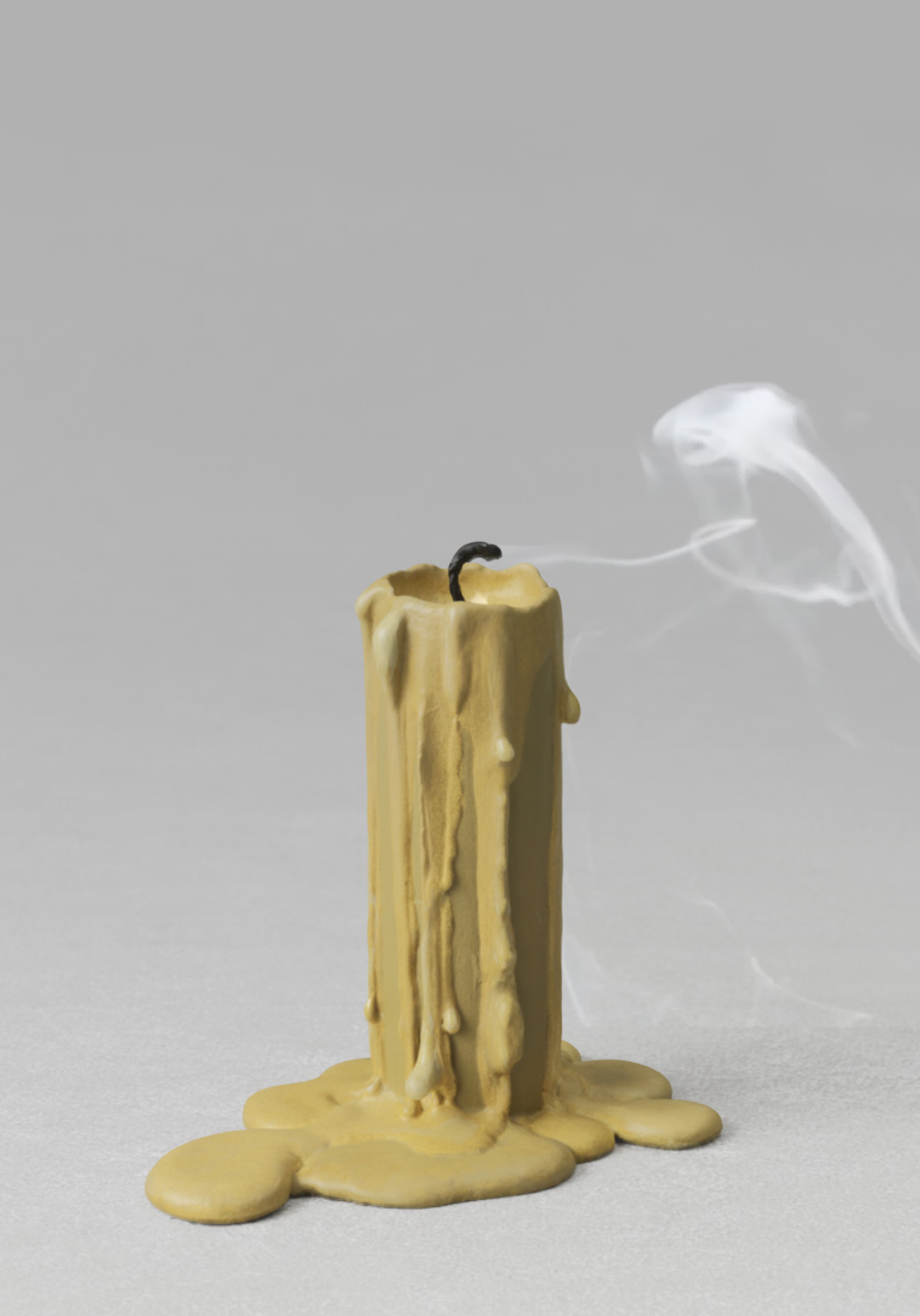This is still.life (Moss Green Candle) by Ugo Rondinone (Ooo -go Ron – di – no – nay). Well, it’s a photograph of it that I’ve borrowed from his website.
Ugo’s sculpture is made from lead, carefully controlled in its molten state to form a candle, which is then cast in bronze and painted.
He makes them in a range of colours and statures, but this one, this Moss Green one, brings to mind a pretty grim page in the history of Paris;
The story of Les Innocents, a cemetery located in what is now the Les Halles district of the city.
As the Roman Empire collapsed into the singularity that is the Vatican, centres of Christian worship sprang up all over Europe. Literally built on the foundations of their pagan predecessors.
Dark Age Parisians received the “Good News” at some point in the fourth century; most of the earliest Christian burial sites date from this period.
If you were wedged up, you could pay to be interred in the crypt, directly underneath the altar of a funerary chapel. It was like being on the sub-basement level of an express elevator to everlasting peace.
If you weren’t so fortunate, you could pay a great deal less and be buried outside on land owned, and consecrated, by the Church.
Most people were agreed that it was better to buried outside of the city walls; for the living at least. But by the 11th century the population had ballooned to a point where the thriving medieval metropolis of Paris enveloped the once remote necropolis.
By this time, the Church had got its feet well under the table, and its fingers in more pies than you could shake a piece of the True Cross at.
To ensure a monopoly, the Bishop of Paris founded a marketplace at Les Champeaux, next door to the now four-hundred year old burial ground. Where there’s tragedy, there’s trade, after all.
Wanting in on the ground floor, and to curtail the avarice of the Bishopric, His Majesty King Louis VII decreed that the market and its proceeds were now in Royal hands. To soften the blow, Louis built a new church at Les Champeaux, which was renamed “Saint Innocents”.
Their cash-cow slain, the Bishops reverted to their stock in trade; the last rights of the departed. In a last ditch attempt to claw back some of their revenue, the cemetery was opened up as a secondary marketplace; An overspill. That was, until King Philippe Auguste demanded that the site be walled and gated.
Luckily for the Church, but mostly because they were expert in persuasion, religious fervour really caught on in the 13th century.
You were a nobody unless you left a sizeable chunk of your estate to the diocese – in more ways than one; a Papal Edict decreed that those who failed to do so would be excommunicated and null in the eyes of God.
Anybody who was anybody was clamouring to evade the fires of Hell, and the easiest way to do that was to be buried, with full rights, in consecrated ground. But it came at a price; and those prices kept climbing. The clergy saw to that.
The cemetery at Les Innocents was filling up fast. Business was booming.
The Black Death swept through the city in the summer of 1418 leaving 50,000 people dead in just five weeks. Pits that could hold up to 1500 bodies were dug as a matter of course. The modestly sized inner city cemetery was filled well beyond capacity. But still the putrid punters kept coming.
By the 1600s, grave diggers were resorting to shambolic show funerals and dismembering corpses out of sight of their blubbering relatives.
Limbs and heads hacked off and burnt, before the charred bones were carted off and piled up in makeshift Charnel Houses. The remaining torsos now merely thrown onto the increasingly gelatinous ground, in the hopes that the “flesh eating qualities” of the ooze that passed for soil would absorb yet another few pounds of flesh.
By now, the haze of putrefaction filled the air to such an extent that reports describe; being able to watch meat on butcher’s blocks dissolving into fetid piles, wine barrels souring to vinegar overnight, and tapestries being drained of all colour.
Petitions to the King from local residents sought to call time on the Church’s lucrative lychgate racket. But they were onto a good thing. How else were they going to rake in this much cash?
Their response was to raise burial fees still further in order to deter all but the wealthiest cadavers.
Something had to give. And on the evening of Tuesday 30th May 1780, it did.
It had been a curiously wet and humid spring. The ground had been soaked for weeks on end; all of April’s showers had come at once, and May’s warm sunshine only partly visible through low broken cloud.
In a neighbouring cellar, a wall which backed up to the cemetery had begun to sweat a foul smelling liquid some weeks before. Unbeknown to the occupants, some of the masonry had bulged out of plum.
Without warning, and with incredible ferocity, the whole lot imploded with the force of a thousand years of internments behind it; Sending an avalanche of corporeal sludge through the entire space.
The building was evacuated, and attempts were made to shore up the damage but it was too little, too late. Burials at Les Innocents had to cease.
But, hang on … what’s this got to do with candles?
The whole area had become such a loathsome mess that there was nothing else to do but clear it.
Hundreds of impoverished and strong stomached men, women and children mucked in to remove and transpose the bones an estimated six million people. Pay and conditions were inhuman, but there was a profitable sideline;
The byproduct of this process was the greasy human soup in which the bones were suspended.
Tonnes of the gangrenous gunge was sold to candle makers and rendered into human tallow. Across the city, the residents of Paris lit their hovels, houses, hospitals and palaces by the light of their forebears.
It took almost 30 years to exhume what remained and lay it all to rest within the now famous Catacombs. Some of the most tumultuous years in the history of France.
UGO RONDINONE, “STILL.LIFE. (MOSS GREEN CANDLE)”, 2013. CAST BRONZE, LEAD, PAINT. 10 CM × 11 CM × 8 CM
Watch the IGTV video: @studio_chrishodson


